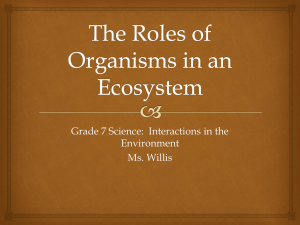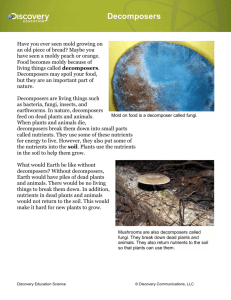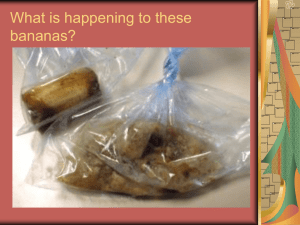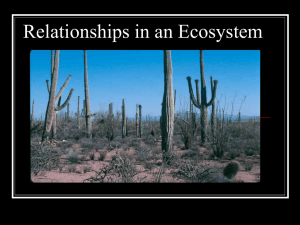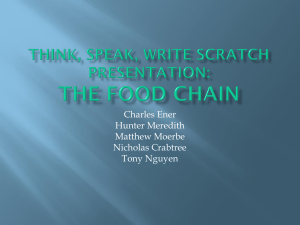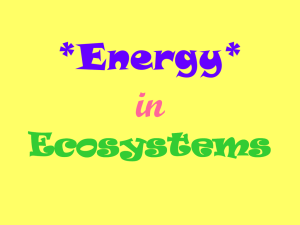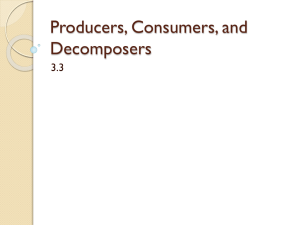Lesson 6: Matter Cycles - Grade 7 Science is Awesome!
advertisement
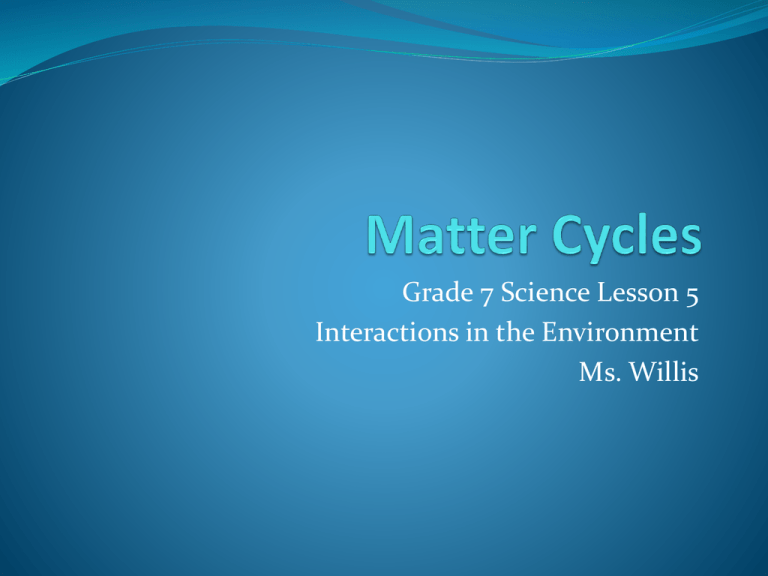
Grade 7 Science Lesson 5 Interactions in the Environment Ms. Willis Matter Cycles Learning Goals: Describe how matter is cycled in the environment and how this contributes to sustainability Success Criteria: I can explain the terms cycle, closed system and sustainable. I can describe the carbon and water cycle. Matter Cycles We have looked at how energy moves in one direction in ecosystems through food webs and food chains. Matter also moves in ecosystems. Think about it...what happens to matter- the leaves, roots, bones, hair, muscles, and every other part of an organism in an ecosystem? Earth is a closed system. A closed system is one in which no new matter can enter and no matter can leave. The amounts of carbon, water, oxygen, hydrogen, and nitrogen on Earth are the same now as they were when dinosaurs were alive. However, organisms are continuously using these materials to stay alive. How do the amounts of matter on Earth remain the same over long period of time??? Matter Cycles The answer is through recycling. Matter is taken up from the environment, used in life processes, and eventually returned to the environment where it can be used again. Ecologists call this repeating pattern a cycle. Closed system: a system in which the amount of matter remains constant over time Cycle: a pattern in nature that repeats over time The Clean-Up Squad Detrivores and decomposers recycle in an ecosystem. As you have already learned, detrivores and decomposers eat the remains of dead plants and animals that scavengers and other consumers have left behind. The also feed on animal wastes. Detrivores break up organic waste into smaller particles. When decomposers feed, they break down these smaller pieces into simple substances such as minerals, nitrates, and phosphates. These substances are left in the soil as nutrients that plants can absorb. The Clean-Up Squad Decomposers play a critical role in any ecosystem. They convert biotic elements, such as plant and animal matter, into abiotic elements, such as minerals. They allow matter to be recycled and reused by other organisms in the ecosystem. The Clean-Up Squad Scavengers like this turkey vulture feed on already dead animals and leave behind decaying matter. Detrivores such as earthworms break down the organic matter into small pieces decomposers like this fungus break down the remaining matter, releasing nutrients back into the ecosystem Discuss: Can anyone think of an example of matter being recycled??? Have you seen this happen anywhere??? An Example of Matter Being Recycled: A composter is a perfect example of matter being recycled. Food and plant wastes are put into a container. Earthworms and other detrivores break down large pieces of decaying matter into small pieces. Bacteria, fungi, and other decomposers then further break down these pieces into nutrient particles. The final product is compost. Gardeners mix nutrientrich compost into the existing soil. Garden plants then use these nutrients to grow. Ecosystems are Sustainable Without scavengers, detrivores, and decomposers, Earth would be piled high with dead organisms! For example, the leaves that fall from trees would still be there in the spring, continuing to pile up year after year. With no new nutrients being added to the soil, plants would slowly starve and die. As a result, animals would also starve and die. Ecosystems are Sustainable Healthy ecosystems are sustainable, which means that they can be maintained indefinitely. They can replenish resources by continuously recycling matter. Example: a bear catches a fish, eats most of it, and leaves the carcass to rot into the soil. The nutrients in the carcass are released by decomposers. Forest trees use these nutrients to grow and say healthy. The healthy forest provides a home and food for the bear. This is a cycle! Now comes the complicated stuff!..... We will be looking at two important cycles in nature: Carbon and Water The Carbon Cycle What is carbon? “A naturally abundant nonmetallic element that occurs in many inorganic and in all organic compounds…” This is a big definition! Here is a simplified version: Carbon is found in many places on Earth. It is found in abiotic elements, such as coal, oil, and natural gas, and in the air as carbon dioxide. Carbon is also found in all living things. The Carbon Cycle 1. Plants use carbon dioxide in photosynthesis to produce sugars. (Recall our photosynthesis diagram!) Notice that CARBON is one of the elements used in photosynthesis to make SUGARS (food) and oxygen. The Carbon Cycle 2. When animals and other organisms break down these sugars to obtain energy, they produce water and carbon dioxide. Animals also release waste carbon dioxide when they exhale, or breath out. 3. When decomposers break down dead plants and animals, they too release carbon dioxide. 4. All of the carbon dioxide released into the air by these processes is available to plants for photosynthesis. The cycle starts again. The Carbon Cycle – Simplified The Carbon Cycle – More realistic The Carbon Cycle This video explains the cycle: The Carbon Cycle The Carbon Cycle – No Longer in Equilibrium? Carbon in dead plants that are buried in soil may not decompose completely. This organic matter remains underground for millions of years where it undergoes chemical changes to form fossil fuels such as coal, oil, and natural gas. How does this change things? The Carbon Cycle – No Longer Sustainable? When humans burn fossil fuels, most of the carbon quickly enters the atmosphere as carbon dioxide. Carbon dioxide is a gas that stays in Earth's atmosphere and absorbs the energy radiated by Earth and the Sun. This contributes to the warming of Earth's surface. Gases that trap energy in Earth's atmosphere are known as greenhouse gases. Earth would be a frozen world without greenhouse gases. The Carbon Cycle – No Longer Sustainable? However, humans have burned so much fossil fuel that there is about 30% more carbon dioxide in the air today than there was 150 years ago. This is resulting in “global warming” with some devastating effects. Video: Global Warming The Water Cycle Water keeps all living things alive. Most living things are made largely of water. Water also moves in a cycle. The Water Cycle The water cycle begins with evaporation (the change in state of a substance from liquid to gas). As the sun's energy warms up oceans, lakes, and rivers, some of the water evaporates to form water vapour. Large amounts of water vapour also escape from plant leaves. The water vapour rises in the atmosphere, contracting as it cools to form tiny water droplets. The Water Cycle The change of state from a gas to a liquid is called condensation. These are the tiny water droplets that result from the condensation of water vapour from clouds. As more and more droplets condense, they fall back to Earth as rain or snow, also called precipitation. The Water Cycle Precipitation may also seep into the ground and remain trapped there for years as groundwater. Groundwater also eventually seeps into large bodies of water. At any stage in the cycle, the water may evaporate back into the atmosphere. Nature recycles water so that it can be used again and again! The Water Cycle Definitions Evaporation: the process in which a substance changes state from liquid to gas Condensation: the change of state of a substance from gas to liquid Precipitation: water in the liquid or solid state that falls to Earth. The Water Cycle Video: The Water Cycle We all need clean fresh water to survive, but the supply of fresh water on Earth is limited. Humans are using fresh water faster than it can be replenished by the water cycle because of higher populations and pollution. (You will study this more in geography!) We need to ALL understand the importance of water to protect clean water for the future! Lesson Review: Key words: cycle, closed system, sustainable, evaporation, condensation, precipitation Key concepts: role of detrivores/decomposers as recyclers carbon cycle water cycle
